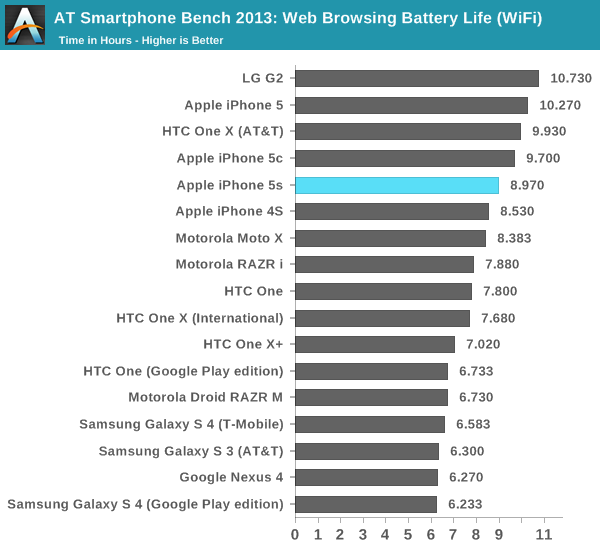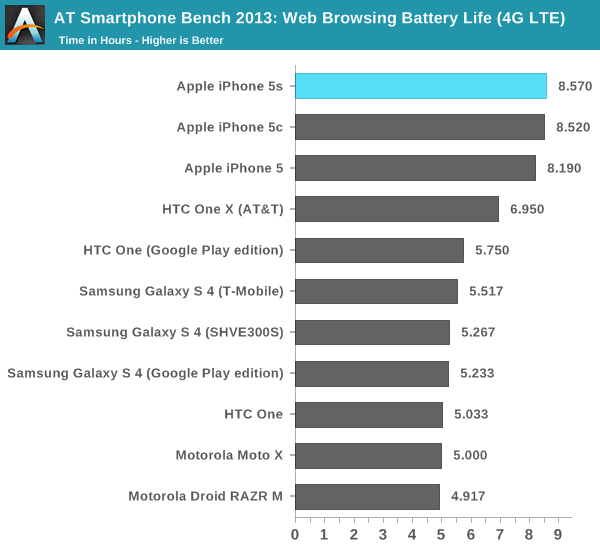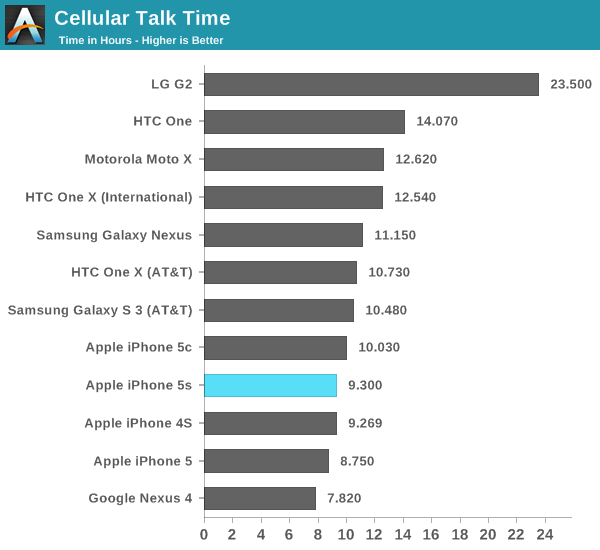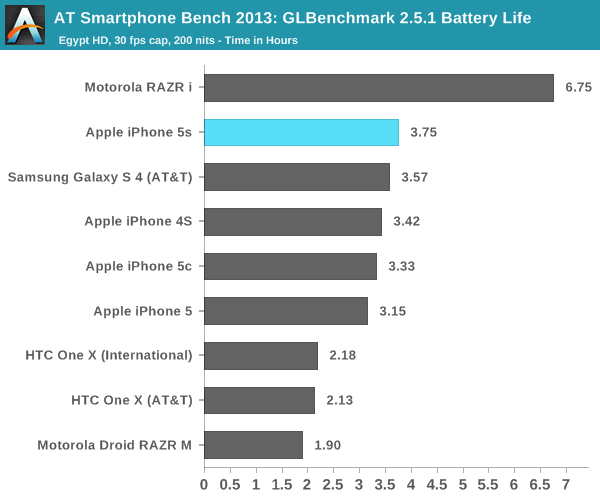The iPhone 5s Review
by Anand Lal Shimpi on September 17, 2013 9:01 PM EST- Posted in
- Smartphones
- Apple
- Mobile
- iPhone
- iPhone 5S
Battery Life
Brian did some excellent sleuthing and came across battery capacities for both the iPhone 5s and 5c in Apple’s FCC disclosures. The iPhone 5 had a 3.8V 5.45Wh battery, while the 5s boosts total capacity to 5.96Wh (an increase of 9.35%). The move to a 28nm process doesn’t come with all of the benefits of a full node shrink, and it’s likely not enough to completely offset the higher potential power draw of a much beefier SoC. Apple claims the same or better battery life on the 5s compared to the iPhone 5, in practice the answer is a bit more complicated.
Unlike previous designs, we’ve never had a half node shrink for an s-SKU. Both the iPhone 3GS and iPhone 4S stayed on the same process node as their predecessor and drove up performance. In the case of the 3GS, the performance gains outweighed their power cost, while in the case of the iPhone 4S we generally saw a regression.
The iPhone 5s improves power consumption by going to 28nm, but turns that savings into increased performance. The SoC also delivers a wider dynamic range of performance than we’ve ever seen from an Apple device. There’s as much CPU power here as the first 11-inch MacBook Air, and more GPU power than an iPad 4.
To find out the balance of power savings vs. additional performance I turned to our current battery life test suite, which we first introduced with the iPhone 5 review last year.
We'll start with our WiFi battery life test. As always, we regularly load web pages at a fixed interval until the battery dies (all displays are calibrated to 200 nits).

The iPhone 5s regresses a bit compared to the 5 in this test (~12% reduction despite the larger battery). We're loading web pages very aggressively here, likely keeping the A7 cores running at their most power hungry state. Even the 5c sees a bit of a regression compared to the 5, which makes me wonder if we're seeing some of the effects of an early iOS 7 release here.
The story on LTE is a bit different. Here we see a slight improvement in battery life compared to the iPhone 5, although the larger battery of the 5s doesn't seem to give it anything other than parity with the 5c:

Our cellular talk time test is almost entirely display and SoC independent, turning it mostly into a battery capacity test:

You can see the close grouping of the smaller iPhones at the bottom of the chart. There's a definite improvement in call time compared to the iPhone 5. We're finally up above iPhone 4S levels there.

Our Egypt HD based 3D battery life test gives us the first indication that Rogue, at least running fairly light code, can be more power efficient than the outgoing 5XT. Obviously the G6430 implemented here can run at fairly high performance levels, so I'm fully expecting peak power consumption to be worse but for more normal workloads there's no regression at all - a very good sign.










464 Comments
View All Comments
solipsism - Wednesday, September 18, 2013 - link
I hadn't seen such a concise explanation of this tech. Thanks.Dug - Wednesday, September 18, 2013 - link
Very interesting and strange no one else has thought of doing this. I know using Nikon's system (CLS) exposure seems to be always right on, but depending on white balance setting it always needs adjustment.zshift - Tuesday, September 17, 2013 - link
Awesome review! A great read, as always.Dman23 - Tuesday, September 17, 2013 - link
Another awesome review by Anand Lal Shimpi! Informative and on point... love it.Crono - Tuesday, September 17, 2013 - link
I want to point out for the sake of consistency that Apple's naming convention is to use lowercase letters after the number for the iPhones. So it's "4s", not "4S", at least according to their website. It's annoying, I know, just pointing it out because it confused me at first so I looked it up.dylan522p - Tuesday, September 17, 2013 - link
Yeah, Brian went on a twitter rant of sorts about it. Pretty small but annoying change.tipoo - Tuesday, September 17, 2013 - link
Am I wrong, or is this the highest IPC smartphone core out there? 1.3 GHz, dual core, and it still doubles the performance of the A6 landing it into the territory most phones take higher clocked quads to get into.doobydoo - Wednesday, September 18, 2013 - link
Landing it way beyond all the current quad core phones.UpSpin - Wednesday, September 18, 2013 - link
Browserbenchmarks != CPU performanceSo it's possible that the good Browser benchmarks result more in a better optimized JS engine built for the A7? (because Samsung, NVidia, MS, ATI, Intel, ... all cheat in benchmarks, it's even possible that Apple still uses the not further optimized JS and Browser engine for the 5C, to increase the gap between A6 and A7 and make people believe the better browser scores are because of the A7, instead it's just heavy software optimization?)
Isn't it odd that a RAW CPU benchmark (3D Mark unlimited - Physics) positions the iPhone 5S on the same step as 5C and 5? (assuming there is no bug). 3D Mark also probably doesn't take advantage of 64-bit, but so will no near future App either, especially, because of the limited RAM, Games won't take 64-bit in the future either, else they'll blow the RAM limit more easily.
ScienceNOW - Tuesday, September 17, 2013 - link
F'ing thing sucks! I can all write it and we do it live! we do it live!